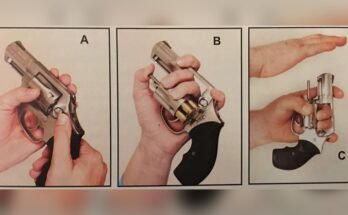Have you ever faced unexpected problems with your swing-out cylinders that slow down your work or cause frustration? If so, you’re not alone.
These small but important parts can develop common issues that affect how smoothly your equipment operates. Understanding these problems early can save you time, money, and stress. You’ll discover the most frequent issues with swing-out cylinders and how to spot them before they become a bigger hassle.
Keep reading to protect your gear and keep everything running smoothly.

Swing-out Cylinder Basics
Swing-out cylinders are a type of hydraulic or pneumatic device. They help move objects by swinging out from a fixed point. These cylinders are common in many machines and tools. Understanding their basics is key to spotting problems early.
These cylinders save space and allow easy access to work areas. Their design makes them useful for tasks needing a swinging motion. Knowing how they work and where they are used helps maintain them better.
How Swing-out Cylinders Work
Swing-out cylinders use fluid pressure to create movement. The cylinder pushes or pulls a rod that swings around a pivot point. This swinging motion moves parts or tools in machines. The pivot point lets the cylinder move side to side, not just in and out.
The cylinder has seals to hold the fluid inside. It also has a housing to protect moving parts. When fluid enters, the rod extends and swings the attached part. When fluid leaves, the rod retracts, bringing the part back.
Common Applications
Swing-out cylinders appear in many industries. They are found in manufacturing machines, construction equipment, and automotive lifts. These cylinders help move heavy parts or open and close gates.
They are useful in places with limited space. The swinging action allows machines to work in tight spots. This makes tasks easier and faster. Many factory and farm machines depend on these cylinders for smooth operation.
Frequent Mechanical Problems
Swing-out cylinders face common mechanical problems that reduce their performance. These issues often cause delays and increase repair costs. Understanding these problems helps in maintaining the cylinders better. Below are some frequent mechanical problems that affect swing-out cylinders.
Hinge Wear And Tear
Hinges on swing-out cylinders move often. This constant movement causes wear and tear. Over time, hinges may become loose or rusty. Loose hinges cause the cylinder to swing unevenly. Rust can block smooth movement. Regular inspection and lubrication can reduce hinge problems.
Cylinder Misalignment
Misalignment happens when the cylinder does not fit properly. This issue causes the cylinder to jam or move with difficulty. Misalignment often occurs after heavy use or impact. It increases stress on other parts. Fixing alignment early prevents bigger damage and keeps the cylinder working smoothly.
Seal Leakage
Seals keep fluids inside the cylinder. Leakage means fluids escape from the cylinder. This reduces pressure and cylinder power. Seal leakage can cause the cylinder to fail. Damage to seals happens due to wear or poor installation. Checking seals regularly helps catch leaks early.
Operational Issues
Operational issues with swing-out cylinders can disrupt their performance. These problems often affect the smooth functioning and reliability of the equipment. Identifying these issues early helps in keeping the cylinders working efficiently.
Slow Or Jerky Movement
Slow or jerky movement signals a problem inside the cylinder. Dirt or debris may block the cylinder’s path. Worn seals can also cause uneven motion. This issue reduces the cylinder’s efficiency and speed.
Difficulty Swinging Out
Difficulty swinging out means the cylinder does not move freely. Rust or corrosion can cause this stiffness. Lack of lubrication also makes the movement hard. Regular maintenance prevents this kind of trouble.
Unusual Noises
Unusual noises like grinding or squeaking are warning signs. They suggest friction between parts or loose components. These sounds often mean the cylinder needs inspection or repair. Ignoring them can lead to bigger problems.

Maintenance Challenges
Swing-out cylinders require regular care to work well. Maintenance challenges can reduce their lifespan and efficiency. Proper upkeep helps avoid breakdowns and costly repairs. Below are common maintenance issues with these cylinders.
Lubrication Problems
Lubrication keeps swing-out cylinders moving smoothly. Lack of oil causes friction and wear. Over time, this can damage seals and pistons. Use the right lubricant for your cylinder type. Apply it regularly to prevent sticking and noise.
Corrosion And Rust
Metal parts face moisture and rust risks. Rust weakens cylinder surfaces and can cause leaks. Clean cylinders often to remove dirt and water. Use rust-resistant coatings or paint to protect metal. Store cylinders in dry places when not in use.
Regular Inspection Tips
Check cylinders often for leaks, cracks, or damage. Look for worn seals and loose bolts. Test cylinder movement for smoothness and speed. Keep a maintenance log to track issues and repairs. Early detection saves time and money.
Safety Concerns
Safety is a top concern with swing-out cylinders. These devices handle heavy loads and high pressure. Any failure can lead to serious accidents. Understanding the safety risks helps prevent harm and damage. Regular checks and proper use are key to safety.
Risk Of Cylinder Failure
Swing-out cylinders can fail due to wear or damage. Leaks, cracks, or corrosion weaken the cylinder. Sudden failure can cause the load to drop. This poses a threat to nearby workers and equipment. Overloading or improper installation increases failure risk. Regular inspection helps spot problems early.
Preventing Accidents
Follow safety guidelines when using swing-out cylinders. Use the right size and type for the job. Inspect cylinders before every use for signs of damage. Replace worn or faulty parts immediately. Train workers on safe handling and emergency procedures. Proper maintenance keeps cylinders reliable and safe.

Troubleshooting Steps
Troubleshooting swing-out cylinders helps fix common issues fast. Understanding the right steps can save time and money. These steps guide you through checking and fixing problems easily.
Diagnosing Common Faults
Start by inspecting the cylinder for leaks or damage. Listen for unusual noises during operation. Check if the cylinder moves smoothly without sticking. Look for signs of rust or wear on the rod. Test the pressure to ensure it matches the specifications. Watch for slow or uneven movement, which can indicate internal issues.
When To Replace Parts
Replace seals if you find leaks or worn edges. Change the piston rod if it is bent or heavily scratched. Swap out the cylinder if it shows cracks or severe corrosion. Replace parts that cause constant failure to avoid repeated repairs. Use original or high-quality parts for better durability and performance.
Improving Cylinder Performance
Improving the performance of swing-out cylinders helps avoid common problems. It keeps machines running smoothly and extends cylinder life. Small changes can make a big difference in how well cylinders work.
Upgrading Components
Using better parts can improve cylinder function. Choose seals and rods made from stronger materials. These upgrades reduce wear and stop leaks early. High-quality components handle pressure and movement better. This lowers the chance of breakdowns and costly repairs.
Best Practices For Longevity
Regular checks help find issues before they grow. Keep cylinders clean and lubricated to reduce friction. Avoid overloading cylinders beyond their limits. Store cylinders in dry places to stop rust. Simple habits protect cylinders and keep them working longer.
Frequently Asked Questions
What Causes Swing-out Cylinders To Malfunction?
Swing-out cylinders often malfunction due to wear and tear. Common causes include seal leaks, corrosion, and piston damage. Regular maintenance helps prevent these issues and ensures smooth operation.
How Can I Identify Cylinder Seal Leaks?
Look for hydraulic fluid around the cylinder area. Leaks cause reduced pressure and slower cylinder movement. Inspect seals regularly to catch leaks early and avoid costly repairs.
Why Do Swing-out Cylinders Corrode Quickly?
Exposure to moisture and harsh environments speeds up corrosion. Lack of protective coatings worsens the problem. Use corrosion-resistant materials and proper lubrication to extend cylinder life.
What Maintenance Prevents Swing-out Cylinder Failures?
Regular inspection, cleaning, and lubrication are key. Replace worn seals and damaged parts promptly. Proper maintenance improves performance and avoids unexpected breakdowns.
Conclusion
Swing-out cylinders often face wear and seal leaks. Dirt and rust cause sticking or slow movement. Regular checks help spot problems early. Fixing issues quickly saves time and money. Understanding these common problems keeps equipment working well. Stay alert to sounds or leaks during use.
Proper care extends the life of your cylinders. Simple maintenance avoids costly repairs later on. Keep your swing-out cylinders smooth and reliable.



